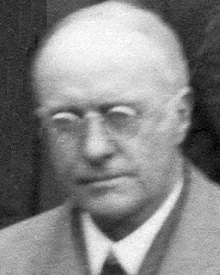Theodore Lyman IV facts for kids
Quick facts for kids
Theodore Lyman
|
|
|---|---|
 |
|
| Born | November 23, 1874 |
| Died | October 11, 1954 (aged 79) |
| Alma mater | Harvard University |
| Awards | Elliott Cresson Medal (1931) |
| Scientific career | |
| Fields | Spectroscopy |
Theodore Lyman IV (born November 23, 1874 – died October 11, 1954) was an American physicist and spectroscopist. A physicist is a scientist who studies how the universe works, including energy and matter. A spectroscopist studies how light interacts with matter. Theodore Lyman was born in Boston. He went to Harvard and earned his first degree in 1897. He then continued his studies and received his Ph.D. (a very high degree) in 1900.
Contents
The Life and Work of Theodore Lyman
Theodore Lyman was a brilliant scientist who made important discoveries about light. He spent most of his career at Harvard University, where he taught and led research. His work helped us understand more about different types of light, especially light we cannot see.
Lyman's Career at Harvard University
After finishing his studies, Lyman became a physics professor at Harvard. He started as an assistant professor and became a full professor in 1917. He also directed the Jefferson Physical Laboratory from 1908 to 1917. This was a special place where scientists did experiments and made new discoveries.
Lyman focused his research on how light behaves. He studied things like diffraction gratings, which are tools that split light into different colors. He also looked at wavelengths, which measure the distance between waves of light.
Discovering Vacuum Ultraviolet Light
One of Lyman's most important contributions was his work on ultraviolet light. This is a type of light that humans cannot see, but it is part of the electromagnetic spectrum. He specifically studied "vacuum ultraviolet light," which is ultraviolet light that can only travel through a vacuum (like space) because it is absorbed by air.
Lyman built special equipment to study these very short wavelengths of light. His research helped scientists understand more about how light interacts with different materials. He published many important papers about his findings, sharing his knowledge with other physicists.
Military Service During World War I
During World War I, Theodore Lyman took a break from his scientific work to serve his country. He joined the American Expeditionary Force in France. He held the rank of major in the engineering division. This shows his dedication beyond the laboratory.
Honors and Legacy
Theodore Lyman's work had a lasting impact on science. He received many honors for his important discoveries.
- Lyman Series: A set of specific spectral lines (like a unique fingerprint of light) is named after him. These lines are created when electrons in a hydrogen atom jump between energy levels.
- Lyman Crater: There is a crater on the far side of the Moon named "Lyman" in his honor.
- Elliott Cresson Medal: In 1931, he was given the Franklin Institute's Elliott Cresson Medal. This is a very important award for scientific achievements.
- Lyman Laboratory of Physics: The physics building at Harvard University, where he did much of his research, is named the Lyman Laboratory of Physics.
See also
 In Spanish: Theodore Lyman para niños
In Spanish: Theodore Lyman para niños

